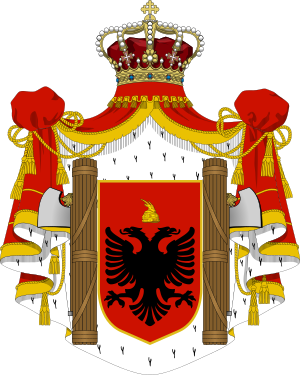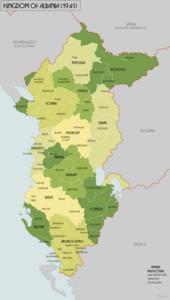Italian occupation of Albania
| date | April 7, 1939 to April 12, 1939 |
|---|---|
| place | Kingdom of Albania |
| output | Victory of Italy |
| consequences | Occupation of Albania by Italy |
| Parties to the conflict | |
|---|---|
| Commander | |
| Troop strength | |
| 22,000 men | 14,000 men |
| losses | |
|
25 dead, 97 injured |
160 dead |
The Italian occupation of Albania was a short campaign by the fascist Kingdom of Italy against the Kingdom of Albania and lasted from April 7 to April 12, 1939. On April 16, Albania was joined in personal union with the Kingdom of Italy and remained until the Armistice of Cassibile (1943 ) occupied by Italian troops.
prehistory
Even before the occupation of Albania, Italy had such great influence in Albania that the Kingdom of Albania was de facto an Italian protectorate . This was because the Albanian President Ahmet Zogu wanted to limit the influence of the Kingdom of Yugoslavia in Albania after he came to power in 1925 . He was now looking for a suitable partner for this project among the major European powers. Zogu found this partner in Italy, which had been ruled by the fascist dictator Benito Mussolini since 1922 . Mussolini pursued expansive interests in the Balkans and Albania now had the opportunity to exert direct influence. Zogu also urgently needed donors in order to invest in the country and meet its government spending and thereby stabilize his rule.
In 1925 Rome and Tirana signed a secret military agreement. Albania had to sign the two so-called Tirana Pacts in 1926 and 1927 . As a result, Italy practically took over the protection of the country and made Albania even more dependent. In 1928 Zogu was proclaimed King of the Albanians . But this could not hide the growing influence of Mussolini.
After the annexation of Austria and the invasion of the German Reich in Czechoslovakia ( " destruction of the remainder of Czechoslovakia ") is Italy saw as increasingly smaller partners in the Pact of Steel . So after the German invasion of Czechoslovakia , Mussolini decided to annex Albania. Italy's King Victor Emmanuel III. refused this plan as he believed it involved unnecessary risks. Despite this, Mussolini demanded that Zogu tolerate the military occupation of Albania by Italy. But this would have meant giving up Albania's sovereignty entirely. Zogu refused to accept the Italian ultimatum.
The invasion
On April 7, 1939, Italian units led by General Alfredo Guzzoni attacked the Albanian ports of Saranda , Vlora , Durrës and Shëngjin at the same time . The Albanian armed forces were poorly trained and poorly equipped. Many of the cadres and trainers were Italian. So Albania had little to oppose the Italian army.
Zogu made a radio appeal for civilians to resist. This proved ineffective as very few people owned a radio receiver at the time . Only in the city of Durrës did a group of civilians and gendarmes under the head of the local gendarmerie Mujo Ulqinaku put up any significant resistance. They managed to delay the landing of the Italian ships by five hours.
On the same day, Ahmet Zogu fled into exile with his family and 2,000 members of the government, advisors and officers. On April 8th, Italian troops occupied Tirana; until April 12th the whole country was in their hands.
The Albanian parliament decided on April 12th to remove Zogu. The Albanian crown was given to King Victor Emmanuel III of Italy . to hand over. In the following years Albania was ruled in personal union with Italy.
consequences
Albania was now under full control of Italy. An Italian governor was installed. Under this an Albanian puppet government was formed; Prime Minister Shefqet Vërlaci became the landowner . Albania had to follow Italy on the Axis side into World War II. On October 28, 1940, Italy invaded Greece from Albania, starting the Greco-Italian War . In the same year, however, the Italian troops were pushed far back into Albania.
In the German Balkan campaign from April 1941, Yugoslavia and Greece were conquered by German troops and occupied by German, Italian, Hungarian and Bulgarian troops. The Kosovo and the region around Ulcinj in Montenegro and parts of present-day Nordmazedoniens were connected to the now Italian Albania. This state structure was called Greater Albania . After the Italian surrender on September 8, 1943, units of the German Wehrmacht occupied Albania and disarmed the Italian troops.
After the invasion in 1939, the first partisan groups emerged (for example, the dismissed police and army officers Abaz Kupi , Myslim Peza and Muharram Bajraktari formed some).
When the Wehrmacht - namely Army Group E - evacuated the Balkan region during the Belgrade operation (September 14 to November 24, 1944) ( see also: Belgrade Operation # Result ), communist partisan groups were well prepared to fill the power vacuum in the country.
Ahmet Zogu remained in exile throughout his life. Only his son Leka Zogu was able to return to Albania in 1993 - 54 years after his escape.
literature
- Hubert Neuwirth: Resistance and Collaboration in Albania 1939–1944 (= Albanian Research . Volume 27 ). 1st edition. Harrassowitz, Wiesbaden 2008, ISBN 978-3-447-05783-7 ( limited preview in the Google book search - revised version of Neuwirth's dissertation, University of Graz, Prof. Karl Kaser, 1997).
Web links
Individual evidence
- ^ Neuwirth: Resistance and Collaboration in Albania 1939-1944. P. 42.
- ↑ Renate Ndarurinze: Albania - With Tirana, Adriatic Coast and Albanian Alps Trescher Verlag, Berlin 2012, ISBN 978-3-89794-223-3 , p. 67; 68.
- ^ First to Greece, then to Turkey, up to the western campaign (May / June 1940) to France and from there to Great Britain ( page 405 )
- ↑ Invasion of Albania 7 Apr 1939 - 12 Apr 1939. (en.) Accessed February 11, 2013.
- ^ Edwin E. Jacques: The Albanians: An Ethnic History from Prehistoric Times to the Present , p. 405.






